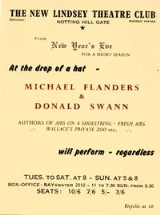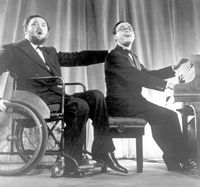
At the Drop of a Hat
Encyclopedia
At the Drop of a Hat is a musical
revue
by Flanders and Swann
, described by them as "An After-Dinner Farrago". In the show, they both sang on a nearly bare stage, accompanied by Swann on the piano
. The songs were linked by contemporary social commentary, mostly by Flanders
.
The show opened at the New Lindsey Theatre, a fringe theatre outside the London
West End theatre
district, on December 31, 1956. It was successful and transferred to the Fortune Theatre
in the West End
on January 24, 1957, where it ran for 808 performances. On October 8, 1959 the show opened in New York City
at the Golden Theater
, running there for 215 performances.
Although they had performed together in the summer of 1940 in a revue they both directed and staged, this was Flanders and Swann's first show performing in the format for which they would become successful, and from 1959 to 1967 they toured with it off and on, performing it a total of 1,700 times over 11 years around the world. The two continued to perform together for three decades.
was produced in 1963.
Each performance ended with the song "Hippopotamus", in which the audience was encouraged to join in, followed, in Britain, by a musical rendition of the Lord Chamberlain's requirements
.

Musical theatre
Musical theatre is a form of theatre combining songs, spoken dialogue, acting, and dance. The emotional content of the piece – humor, pathos, love, anger – as well as the story itself, is communicated through the words, music, movement and technical aspects of the entertainment as an...
revue
Revue
A revue is a type of multi-act popular theatrical entertainment that combines music, dance and sketches. The revue has its roots in 19th century American popular entertainment and melodrama but grew into a substantial cultural presence of its own during its golden years from 1916 to 1932...
by Flanders and Swann
Flanders and Swann
The British duo Flanders and Swann were the actor and singer Michael Flanders and the composer, pianist and linguist Donald Swann , who collaborated in writing and performing comic songs....
, described by them as "An After-Dinner Farrago". In the show, they both sang on a nearly bare stage, accompanied by Swann on the piano
Piano
The piano is a musical instrument played by means of a keyboard. It is one of the most popular instruments in the world. Widely used in classical and jazz music for solo performances, ensemble use, chamber music and accompaniment, the piano is also very popular as an aid to composing and rehearsal...
. The songs were linked by contemporary social commentary, mostly by Flanders
Michael Flanders
Michael Henry Flanders OBE, was an English actor, broadcaster, and writer and performer of comic songs. He is best known to the general public for his partnership with Donald Swann performing as the duo Flanders and Swann....
.
The show opened at the New Lindsey Theatre, a fringe theatre outside the London
London
London is the capital city of :England and the :United Kingdom, the largest metropolitan area in the United Kingdom, and the largest urban zone in the European Union by most measures. Located on the River Thames, London has been a major settlement for two millennia, its history going back to its...
West End theatre
West End theatre
West End theatre is a popular term for mainstream professional theatre staged in the large theatres of London's 'Theatreland', the West End. Along with New York's Broadway theatre, West End theatre is usually considered to represent the highest level of commercial theatre in the English speaking...
district, on December 31, 1956. It was successful and transferred to the Fortune Theatre
Fortune Theatre
The Fortune Theatre is a 432 seat West End theatre in Russell Street, near Covent Garden, in the City of Westminster, built in 1922-4 by Ernest Schaufelberg for impresario Laurence Cowen. The façade is principally bush hammered concrete, with brick piers supporting the roof...
in the West End
West End theatre
West End theatre is a popular term for mainstream professional theatre staged in the large theatres of London's 'Theatreland', the West End. Along with New York's Broadway theatre, West End theatre is usually considered to represent the highest level of commercial theatre in the English speaking...
on January 24, 1957, where it ran for 808 performances. On October 8, 1959 the show opened in New York City
New York City
New York is the most populous city in the United States and the center of the New York Metropolitan Area, one of the most populous metropolitan areas in the world. New York exerts a significant impact upon global commerce, finance, media, art, fashion, research, technology, education, and...
at the Golden Theater
John Golden Theatre
The John Golden Theatre is a Broadway theatre located at 252 West 45th Street in midtown-Manhattan. Designed in a Moorish style along with the adjacent Royale Theatre by architect Herbert J. Krapp for Irwin Chanin, it opened as the Theatre Masque on February 24 1927 with the play Puppets of Passion...
, running there for 215 performances.
Although they had performed together in the summer of 1940 in a revue they both directed and staged, this was Flanders and Swann's first show performing in the format for which they would become successful, and from 1959 to 1967 they toured with it off and on, performing it a total of 1,700 times over 11 years around the world. The two continued to perform together for three decades.
Description
The two-man show was performed with Flanders in a wheelchair (he had polio) and Swann seated at a piano on an otherwise empty stage. The show consisted of a collection of mainly humorous songs, written by them, connected by topical comments. A second revue called At the Drop of Another HatAt the Drop of Another Hat
At the Drop of Another Hat is musical revue by Flanders and Swann, similar in format to its long-running predecessor, At the Drop of a Hat . In the show, they both sang on a nearly bare stage, accompanied by Swann on the piano. The songs were linked by contemporary social commentary, mostly by...
was produced in 1963.
Each performance ended with the song "Hippopotamus", in which the audience was encouraged to join in, followed, in Britain, by a musical rendition of the Lord Chamberlain's requirements
Lord Chamberlain's requirements
The Lord Chamberlain's requirements were a set of four prerequisites for a licence for a production in British theatres. These were printed in theatre programmes so the audience could be aware of them. The Lord Chamberlain's Office had control of theatres until 1968, including censorship of the...
.
Songs

- "A Transport of Delight" (The Omnibus Song)
- "Song of Reproduction"
- "Greensleeves"
- "In the Bath"
- "A Gnu"
- Songs for Our Time:
- "Philological Waltz"
- "Satellite Moon"
- "A Happy Song"
- "A Song of the Weather"
- "The Reluctant Cannibal"
- "Je suis le ténébreux"
- "Design for Living"
- "Tried by the Centre Court"
- "Kokoraki...A Greek Song"
- "Misalliance"
- "(Have Some) Madeira, M'Dear?"
- "Too Many Cookers" (added in later performances and recordings)
- "Vanessa" (added in later performances and recordings)
- "Tried by the Centre Court" (added in later performances and recordings)
- "The Wom Pom"
- "Hippopotamus" (Mud, Mud, Glorious Mud)
Unreleased Songs
A number of songs didn't make it to disc or were released elsewhere. These include;- "The Wompom" (released in the Bestiary of Flanders and Swann)
- "Grandma" (originally part of an extensive Seven Ages of Women from the revue Airs on a shoestring(1953)
- "In the Bath" (later reused in At the Drop of Another Hat)
- "The Warthog" (released in the Bestiary)
- "The Whale (Mopy Dick)" (released in the Bestiary)
- "The Elephant" (released in the Bestiary)
- "Miranda" (Swann's setting to a Greek poem about the Shakespearian character Miranda, precceds "to Kokoraki")
- "Down Below" (written by Sydney Carter/Swann)
- "The 100 Song" (part of the "Songs for our Time" set that never made it to disc, this started out as one of the "Bottom Five" for the revue "Fresh Airs" (1955). It was included out of context in the Extiary)
- "The Great New Motorway" (topical song, originally for the London Show but adopted for any city with unfinished building projects e. g. "The Great New Gardiner Expressway" when in Toronto, 1961, or "The Great New Sydney Opera House" when in Adelaide, 1964)
- "Good Literature" (written by Carter/Swann)
- "Say who you are" (Carter/Swann)
- "Topical Song (Harold Macmillan)" (following Eden's resignation over the Suez Crisis)
- "Sing a Song of Fivepence" (about decimalisation, sang in Australia)
- "Russia is Red, Dilly Dilly" (Sydney Carter, about space race)
- "Commonwealth Fair" (released in the "Extiary")
- "The Lord Chamerlain's Regulations" (A setting to three of the Lord Chamberlain's Regulations; Smoking is Permitted in the Auditorium, The Safety Curtain Must Be Raised and The Public May Leave at the End of Each Performance. Used as encores. Originally from the Revue "Fresh Airs" (1955))

